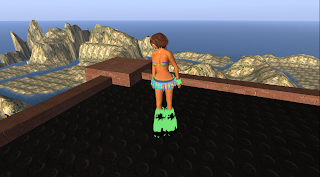GAME ART
I attended Dr. Henry Lowood’s lecture when he came to the
University of Nevada last month. He was able to define “machinima” for me,
since I previously had no idea what it meant: making film with video game
programming and graphics. Lowood explained his classification of machinima
production into three modes: code capture, screen capture, and asset capture.
Code capture involves demo recording and replays in video
games, initially showing up in the mid-1990 first-person shooters. This is a
perfect reproduction of what the player does, without knowing anything about
the player themselves. Screen capture is the recording of video, with the shot
being fixed and unable to be edited without encoding or compression. This gives
more information about the viewpoint or perspective of an event, and what the
player sees rather than does. Finally, asset capture sees the video games as
artifacts and places to “dig” for assets that could not normally be found.
Explorers know how to look for abandoned or future projects that are not meant
to be seen by the players of a game. This was done by the “Noggaholics” of
World of Warcraft. They would utilize private servers, special tools, and
exploitation to document any secret aspects they dug up.
What interested me about this lecture was the creativity and
motivation these people had to create completely new worlds based on previously
created virtual programs. Lowood stressed that these are a few ways that people
are recording events in these other worlds. He stated that the Library of
Congress created a History of Virtual Worlds, which documents events from 2008
to present day. This is very intriguing, because with the advances in
technology we are experiencing today, video games and machinima are very much a
part of everyone’s life. Just as there are ways to preserve other history through
tape recorders, photographs, paper files, etc., there must be ways to preserve
software of our completely computerized history. Lowood was able to open our
minds to different ways people are trying to record this virtual history,
because it should definitely not be lost forever.
POSTCARDS FROM THE GREY AREA - lecture
Secondly, I attended Kevin Kremler’s lecture on “Postcards
from the Grey Area.” His interest in the
“grey area” is based on the fact that it is the undefined space between two
aspects. The grey area has characteristics of different things without it ever
being perfectly clear. He believes that things such as technology and science
in art portray the grey area because they converge in a space between
convenience and inconvenience. Kremler finds humor in a lot of art, and
realizes the instinct of society to appropriate life, such as in reality
television. Through “systems, efficiency, and problem-solving,” he wishes to
let the participants of his art explore the grey area and work outside a
system. He explained that he loves manual labor and tools because he can
exercise problem-solving and see just how far he could push a physical piece of
art. His artwork is very conceptual, physical, and kinetic. By interacting and
personally getting involved with a piece, the viewer gets more interested and
curious. I thought this was all a very cool way to look at art, and it is very
interesting to build projects that directly involve the viewers and invite them
to touch the art and participate. Kremler’s lecture, however, seemed a little
disorganized because I wasn’t completely able to pinpoint what he was
influenced by and what he just wanted to bring attention to. Perhaps that was
the whole point, that his motivation and what his artwork is derived from is a “grey
area” in itself.
POSTCARDS FROM THE GREY AREA - show
For my showing, I went to Kevin Kremler’s exhibition that
was paired with his lecture for “Postcards from the Grey Area” when it was in
the Sheppard Gallery. All of his works were representational of his idea of
interactive, participatory art. He used technology in his pieces, in particular
the one where the viewer could take a photo of themselves as if they were doing
a Rockwell-style self portrait. This was also a unique piece because he invited
the viewer to in essence take and print their own work of art. He also wired
different televisions to show slides of a brain MRI, utilizing technology in
art. In the most eye-catching work of the gallery, Kremler showed his abilities
with tools and kinetic art. It involved two large beams, each with buckets on
each end filled with colored sand. They were on a balance in the middle of the
ceiling, so that when more weight was added to the end of one beam, the entire
structure would raise and lower and turn according to the gravitational shift.
The result of adding sand made a very colorful, random art piece all over the
floor. The entire project relied on the participation of its viewers, which was
really interesting. Kremler was obviously intrigued by the way his viewers
acted and how their own unique personalities influenced their own experience
with his works.







